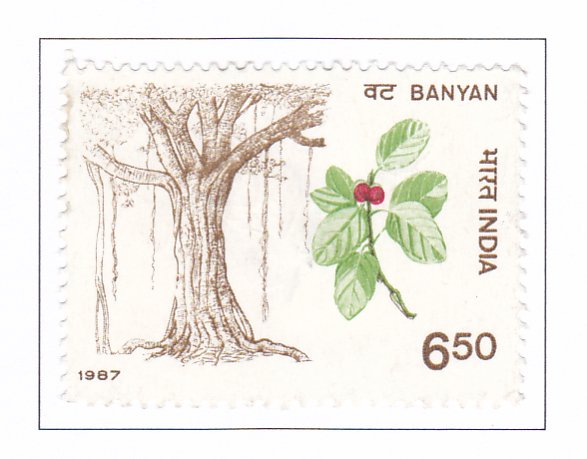Indian Trees: Banyan

Technical Data
| Stamp Set | Indian Trees |
|---|---|
| Date of Issue | November 19, 1987 |
| Denomination | Rs. 6.50 |
| Quantity | 1,500,000 |
| Perforation | comb 13½ x 13 |
| Printer | Security Printing Press, Nashik |
| Watermark | No Watermark |
| Colors | Multicolor |
| Catalog Codes |
Michel IN 1125 Stamp Number IN 1187 Yvert et Tellier IN 941 Stanley Gibbons IN 1274 |
| Themes | Plants (Flora) | Trees |
Commemorative Stamp Set: Indian Trees – The Banyan Tree
Design Elements:
The stamp depicting the Banyan tree could include:
- Majestic Banyan Tree: Showing its large size with a spreading crown, possibly depicting its distinctive aerial roots.
- Leaves: Illustrating its obovate, shiny leaves, with a comparison of the upper and lower surfaces.
- Cultural Significance: Symbols or elements representing its sacred status in Hinduism, possibly including temple scenes.
Cultural and Historical Significance:
The Banyan tree, belonging to the genus Ficus, is a fig tree predominantly found in tropical countries, including India. Known colloquially as ‘Bargad’ or ‘Vat’, it is renowned for its size and beauty, often reaching heights of 30-35 meters. Its broad, spreading crown and aerial roots contribute to its majestic appearance.
Usage:
These stamps serve to highlight the cultural, ecological, and economic significance of trees like the Banyan in India. They promote awareness about biodiversity, the sacred role of trees in religious practices, and the challenges posed by their extensive lateral spread.
Importance of the Commemorative Stamp Set:
The stamp set underscores the vital role of trees as natural gifts that humans are entrusted to preserve and protect. It emphasizes the Banyan tree’s ecological contributions, its sacred status in Hinduism, and the need for sustainable conservation efforts to safeguard such culturally significant species.
Example of the Stamp Design:
The stamp design could vividly capture:
- The grandeur of a mature Banyan tree with its sprawling crown and aerial roots.
- Detailed depiction of its leaves, showcasing their obovate shape, shiny texture, and color contrast.
- Elements representing its cultural significance, such as offerings or temple architecture associated with Banyan trees.
Significance:
By featuring the Banyan tree on a commemorative stamp, it honors India’s diverse cultural and natural heritage. It encourages public appreciation for the Banyan’s ecological role, its sacred symbolism in Hindu traditions, and the importance of preserving such iconic trees for future generations.
